how to read and analyse a text
In literary studies there are various types of close reading. It is possible and rewarding to scrutinise a text closely, keeping any number of its features in mind. These can reveal various layers of significance in the work which might not be apparent on a superficial reading. You might focus attention on the text’s – 
- language
- meaning
- structure
- philosophy
The most advanced forms of close reading combine all these features in an effort to reveal the full and even hidden meanings in a work. The following tutorial shows a very simple form of close reading. It pays attention to the first two of these approaches – looking at the language that Conrad uses and how it is closely linked to what we know about the text.
This type of exercise can only be successful once the text has been read in its entirety. You need a grasp of the events and the story as a whole before it is possible to see how its meaning(s) are built up from small linguistic features of the narrative.
The Russian novelist Vladimir Nabokov once observed ‘Curiously enough, one cannot read a book: one can only re-read it’. What he meant by this apparently contradictory remark is that the first time we read a text we are busy absorbing information, and we cannot appreciate all the subtle connections there may be between its parts – because we don’t yet have the complete picture before us. Only when we read it for a second time (or even better, a third or fourth) are we in a position to assemble and compare the nuances of meaning and the significance of its details in relation to each other.
This is why the activity is called ‘close reading’. You should try to get used to the notion of reading and re-reading very carefully, scrupulously, and in great detail.
The extract which follows is the opening of Conrad’s early story An Outpost of Progress, first published in 1897. It deals with two European characters who have recently arrived at a trading station somewhere in central Africa. If you wish to read the complete story in conjunction with these tutorial notes, it is available free at Project Gutenberg.
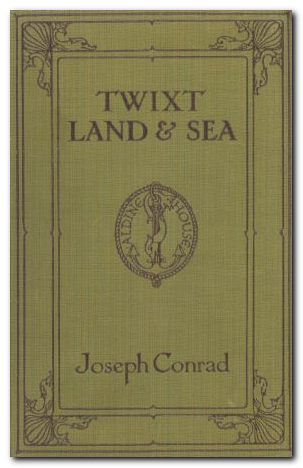
An Outpost of Progress – the opening lines
There were two white men in charge of the trading station. Kayerts, the chief, was short and fat; Carlier, the assistant, was tall, with a large head and a very broad trunk perched upon a long pair of thin legs. The third man on the staff was a Sierra Leone nigger, who maintained that his name was Henry Price. However, for some reason or other, the natives down the river had given him the name of Makola, and it stuck to him through all his wanderings about the country. He spoke English and French with a warbling accent, wrote a beautiful hand, understood bookkeeping, and cherished in his innermost heart the worship of evil spirits. His wife was a negress from Loanda, very large and very noisy. Three children rolled about in sunshine before the door of his low, shed-like dwelling. Makola, taciturn and impenetrable, despised the two white men. He had charge of a small clay storehouse with a dried-grass roof, and pretended to keep a correct account of beads, cotton cloth, red kerchiefs, brass wire, and other trade goods it contained. Besides the storehouse and Makola’s hut, there was only one large building in the cleared ground of the station. It was built neatly of reeds, with a verandah on all the four sides. There were three rooms in it. The one in the middle was the living-room, and had two rough tables and a few stools in it. The other two were the bedrooms for the white men. Each had a bedstead and a mosquito net for all furniture. The plank floor was littered with the belongings of the white men; open half-empty boxes, torn wearing apparel, old boots; all the things dirty, and all the things broken, that accumulate mysteriously round untidy men. There was also another dwelling-place some distance away from the buildings. In it, under a tall cross much out of the perpendicular, slept the man who had seen the beginning of all this; who had planned and had watched the construction of this outpost of progress.
Close reading
01. ‘White men’ is significant because the story is about the exploitation of black Africans by white Europeans. And ‘in charge’ is mildly ironic because we rapidly learn that they are only nominally in charge. It is their African assistant Makola who really determines what goes on, whilst they are hopelessly incompetent.
02. The names ‘Kayerts’ and ‘Carlier’ tell us that the setting of the story is the Belgian Congo. Carlier is a French name, Kayerts is Flemish, and these are the two linguistic groups which comprise Belgium. The physical descriptions contrast the two men in a way that makes them slightly ridiculous, rather like the fat and thin man of comedy stereotypes. The term ‘perched’ reinforces this.
03. ‘Maintained’ suggests just the opposite – that Makola has given himself the name Henry Price because he wants to identify his interests with those of his European employers. Conrad’s use of the racist term ‘nigger’ would have been considered unremarkable in 1897 when he wrote the story.
04. The natives call him ‘Makola’ — and so does Conrad, which reinforces our interpretation of the previous sentence. His ‘wanderings’ suggest that he is experienced.
05. Makola speaks two foreign languages in addition to his own native African language and his wife’s, which would be different. He is also a skilled clerk. Thus he has absorbed European culture, in contrast to the two Europeans, who are completely incapable of absorbing his culture. Yet he still worships evil spirits. He has a foot in both cultures.
06. Loanda is on the coast of Angola, close to what was once called the ‘Slave Coast’. This is why it is ‘Mrs Price’ who understands what the slave traders are saying later in the story.
07. ‘Rolled about’ suggests that the children are at ease in their natural environment. ‘Shed-like’ tells us how poor their accommodation is.
08. ‘Impenetrable’ (a typically Conradian term) suggests that he keeps his feelings and motivation well hidden. It is a similar term to those which Conrad uses later to describe the topographical surroundings – ‘hopeless’ and ‘irresistible’. Such details contribute to why Africa in a moral sense defeats Europe in the story. ‘Despised’ however is a key insight into Makola’s judgement and feelings: this points to the element of racial conflict in the story.
09. We notice that the ‘trade goods’ are an assortment of cheap rubbish. They are being traded for ivory, which is a precious commodity in Europe. The Africans are therefore being cheated by the Europeans. But ‘pretended’ tells us that Makola might be engaged in a little cooking-of-the-books on his own account.
10. ‘Only one large building’: this is a very undeveloped trading station, and its isolation is emphasised.
11. ‘Neatly’ and ‘verandah’ contrast sharply with Makola’s ‘shed-like’ dwelling. In other words, the Europeans have the better accommodation.
12. The furniture is sparse, but the two men have a room each.
13. The mosquito net would be very important: they are close to the equator , and therefore a long way from their European homeland.
14. Notice how the two men do not know how to look after themselves. The floor is ‘littered’ with their ‘broken’ and ‘dirty’ goods. And how inappropriate some of those goods are: they have brought ‘town wearing apparel’ when they are in the tropics.
15. ‘Dwelling place’ is another irony of Conrad’s as the narrator of the story. What he is referring to is the grave of the first station chief who has died of fever. So, Africa has already killed off one representative of Europe when the story opens.
16. Conrad piles on more grim humour with the expression that the first director ‘slept’ under the cross – an ironic euphemism given that the director is dead. There is also a neat structural link here – because this is also the location of the story’s ending, where Kayerts will commit suicide, hanging himself on the cross.
 Studying Fiction is an introduction to the basic concepts and the language you will need for studying prose fiction. It explains the elements of literary analysis one at a time, then shows you how to apply them. The guidance starts off with simple issues of language, then progresses to more complex literary criticism.The volume contains stories by Arthur Conan Doyle, Katherine Mansfield, Thomas Hardy, Joseph Conrad, D.H. Lawrence, and Charles Dickens. All of them are excellent tales in their own right. The guidance on this site was written by the same author.
Studying Fiction is an introduction to the basic concepts and the language you will need for studying prose fiction. It explains the elements of literary analysis one at a time, then shows you how to apply them. The guidance starts off with simple issues of language, then progresses to more complex literary criticism.The volume contains stories by Arthur Conan Doyle, Katherine Mansfield, Thomas Hardy, Joseph Conrad, D.H. Lawrence, and Charles Dickens. All of them are excellent tales in their own right. The guidance on this site was written by the same author.
![]() Buy the book from Amazon UK
Buy the book from Amazon UK
![]() Buy the book from Amazon US
Buy the book from Amazon US

Joseph Conrad’s writing table
Further reading
![]() Amar Acheraiou Joseph Conrad and the Reader, London: Macmillan, 2009.
Amar Acheraiou Joseph Conrad and the Reader, London: Macmillan, 2009.
![]() Jacques Berthoud, Joseph Conrad: The Major Phase, Cambridge: Cambridge University Press, 1978.
Jacques Berthoud, Joseph Conrad: The Major Phase, Cambridge: Cambridge University Press, 1978.
![]() Muriel Bradbrook, Joseph Conrad: Poland’s English Genius, Cambridge: Cambridge University Press, 1941
Muriel Bradbrook, Joseph Conrad: Poland’s English Genius, Cambridge: Cambridge University Press, 1941
![]() Harold Bloom (ed), Joseph Conrad (Bloom’s Modern Critical Views, New York: Chelsea House Publishers, 2010
Harold Bloom (ed), Joseph Conrad (Bloom’s Modern Critical Views, New York: Chelsea House Publishers, 2010
![]() Hillel M. Daleski , Joseph Conrad: The Way of Dispossession, London: Faber, 1977
Hillel M. Daleski , Joseph Conrad: The Way of Dispossession, London: Faber, 1977
![]() Daphna Erdinast-Vulcan, Joseph Conrad and the Modern Temper, Oxford: Oxford University Press, 1991.
Daphna Erdinast-Vulcan, Joseph Conrad and the Modern Temper, Oxford: Oxford University Press, 1991.
![]() Aaron Fogel, Coercion to Speak: Conrad’s Poetics of Dialogue, Cambridge, Mass: Harvard University Press, 1985
Aaron Fogel, Coercion to Speak: Conrad’s Poetics of Dialogue, Cambridge, Mass: Harvard University Press, 1985
![]() John Dozier Gordon, Joseph Conrad: The Making of a Novelist, Cambridge, Mass: Harvard University Press, 1940
John Dozier Gordon, Joseph Conrad: The Making of a Novelist, Cambridge, Mass: Harvard University Press, 1940
![]() Albert J. Guerard, Conrad the Novelist, Cambridge, Mass: Harvard University Press, 1958
Albert J. Guerard, Conrad the Novelist, Cambridge, Mass: Harvard University Press, 1958
![]() Robert Hampson, Joseph Conrad: Betrayal and Identity, Basingstoke: Macmillan, 1992
Robert Hampson, Joseph Conrad: Betrayal and Identity, Basingstoke: Macmillan, 1992
![]() Jeremy Hawthorn, Joseph Conrad: Language and Fictional Self-Consciousness, London: Edward Arnold, 1979
Jeremy Hawthorn, Joseph Conrad: Language and Fictional Self-Consciousness, London: Edward Arnold, 1979
![]() Jeremy Hawthorn, Joseph Conrad: Narrative Technique and Ideological Commitment, London: Edward Arnold, 1990
Jeremy Hawthorn, Joseph Conrad: Narrative Technique and Ideological Commitment, London: Edward Arnold, 1990
![]() Jeremy Hawthorn, Sexuality and the Erotic in the Fiction of Joseph Conrad, London: Continuum, 2007.
Jeremy Hawthorn, Sexuality and the Erotic in the Fiction of Joseph Conrad, London: Continuum, 2007.
![]() Owen Knowles, The Oxford Reader’s Companion to Conrad, Oxford: Oxford University Press, 1990
Owen Knowles, The Oxford Reader’s Companion to Conrad, Oxford: Oxford University Press, 1990
![]() Jakob Lothe, Joseph Conrad: Voice, Sequence, History, Genre, Ohio State University Press, 2008
Jakob Lothe, Joseph Conrad: Voice, Sequence, History, Genre, Ohio State University Press, 2008
![]() Gustav Morf, The Polish Shades and Ghosts of Joseph Conrad, New York: Astra, 1976
Gustav Morf, The Polish Shades and Ghosts of Joseph Conrad, New York: Astra, 1976
![]() Ross Murfin, Conrad Revisited: Essays for the Eighties, Tuscaloosa, Ala: University of Alabama Press, 1985
Ross Murfin, Conrad Revisited: Essays for the Eighties, Tuscaloosa, Ala: University of Alabama Press, 1985
![]() Jeffery Myers, Joseph Conrad: A Biography, Cooper Square Publishers, 2001.
Jeffery Myers, Joseph Conrad: A Biography, Cooper Square Publishers, 2001.
![]() Zdzislaw Najder, Joseph Conrad: A Life, Camden House, 2007.
Zdzislaw Najder, Joseph Conrad: A Life, Camden House, 2007.
![]() George A. Panichas, Joseph Conrad: His Moral Vision, Mercer University Press, 2005.
George A. Panichas, Joseph Conrad: His Moral Vision, Mercer University Press, 2005.
![]() John G. Peters, The Cambridge Introduction to Joseph Conrad, Cambridge: Cambridge University Press, 2006.
John G. Peters, The Cambridge Introduction to Joseph Conrad, Cambridge: Cambridge University Press, 2006.
![]() James Phelan, Joseph Conrad: Voice, Sequence, History, Genre, Ohio State University Press, 2008.
James Phelan, Joseph Conrad: Voice, Sequence, History, Genre, Ohio State University Press, 2008.
![]() Edward Said, Joseph Conrad and the Fiction of Autobiography, Cambridge Mass: Harvard University Press, 1966
Edward Said, Joseph Conrad and the Fiction of Autobiography, Cambridge Mass: Harvard University Press, 1966
![]() Allan H. Simmons, Joseph Conrad: (Critical Issues), London: Macmillan, 2006.
Allan H. Simmons, Joseph Conrad: (Critical Issues), London: Macmillan, 2006.
![]() J.H. Stape, The Cambridge Companion to Joseph Conrad, Cambridge: Cambridge University Press, 1996
J.H. Stape, The Cambridge Companion to Joseph Conrad, Cambridge: Cambridge University Press, 1996
![]() John Stape, The Several Lives of Joseph Conrad, Arrow Books, 2008.
John Stape, The Several Lives of Joseph Conrad, Arrow Books, 2008.
![]() Peter Villiers, Joseph Conrad: Master Mariner, Seafarer Books, 2006.
Peter Villiers, Joseph Conrad: Master Mariner, Seafarer Books, 2006.
![]() Ian Watt, Conrad in the Nineteenth Century, London: Chatto and Windus, 1980
Ian Watt, Conrad in the Nineteenth Century, London: Chatto and Windus, 1980
![]() Cedric Watts, Joseph Conrad: (Writers and their Work), London: Northcote House, 1994.
Cedric Watts, Joseph Conrad: (Writers and their Work), London: Northcote House, 1994.
Joseph Conrad – video biography
Other writing by Joseph Conrad
 Lord Jim (1900) is the earliest of Conrad’s big and serious novels, and it explores one of his favourite subjects – cowardice and moral redemption. Jim is a ship’s captain who in youthful ignorance commits the worst offence – abandoning his ship. He spends the remainder of his adult life in shameful obscurity in the South Seas, trying to re-build his confidence and his character. What makes the novel fascinating is not only the tragic but redemptive outcome, but the manner in which it is told. The narrator Marlowe recounts the events in a time scheme which shifts between past and present in an amazingly complex manner. This is one of the features which makes Conrad (born in the nineteenth century) considered one of the fathers of twentieth century modernism.
Lord Jim (1900) is the earliest of Conrad’s big and serious novels, and it explores one of his favourite subjects – cowardice and moral redemption. Jim is a ship’s captain who in youthful ignorance commits the worst offence – abandoning his ship. He spends the remainder of his adult life in shameful obscurity in the South Seas, trying to re-build his confidence and his character. What makes the novel fascinating is not only the tragic but redemptive outcome, but the manner in which it is told. The narrator Marlowe recounts the events in a time scheme which shifts between past and present in an amazingly complex manner. This is one of the features which makes Conrad (born in the nineteenth century) considered one of the fathers of twentieth century modernism.
![]() Buy the book from Amazon UK
Buy the book from Amazon UK
![]() Buy the book from Amazon US
Buy the book from Amazon US
 Heart of Darkness (1902) is a tightly controlled novella which has assumed classic status as an account of the process of Imperialism. It documents the search for a mysterious Kurtz, who has ‘gone too far’ in his exploitation of Africans in the ivory trade. The reader is plunged deeper and deeper into the ‘horrors’ of what happened when Europeans invaded the continent. This might well go down in literary history as Conrad’s finest and most insightful achievement, and it is based on his own experiences as a sea captain. This volume also contains ‘An Outpost of Progress’ – the magnificent study in shabby cowardice which prefigures ‘Heart of Darkness’.
Heart of Darkness (1902) is a tightly controlled novella which has assumed classic status as an account of the process of Imperialism. It documents the search for a mysterious Kurtz, who has ‘gone too far’ in his exploitation of Africans in the ivory trade. The reader is plunged deeper and deeper into the ‘horrors’ of what happened when Europeans invaded the continent. This might well go down in literary history as Conrad’s finest and most insightful achievement, and it is based on his own experiences as a sea captain. This volume also contains ‘An Outpost of Progress’ – the magnificent study in shabby cowardice which prefigures ‘Heart of Darkness’.
![]() Buy the book from Amazon UK
Buy the book from Amazon UK
![]() Buy the book from Amazon US
Buy the book from Amazon US
© Roy Johnson 2014
Joseph Conrad web links
Joseph Conrad at Mantex
Biography, tutorials, book reviews, study guides, videos, web links.
Joseph Conrad – his greatest novels and novellas
Brief notes introducing his major works in recommended editions.
Joseph Conrad at Project Gutenberg
A major collection of free eTexts in a variety of formats.
Joseph Conrad at Wikipedia
Biography, major works, literary career, style, politics, and further reading.
Joseph Conrad at the Internet Movie Database
Adaptations for the cinema and television – in various languages. Full details of directors and actors, production notes, box office, trivia, and quizzes.
Works by Joseph Conrad
Large online database of free HTML texts, digital scans, and eText versions of novels, stories, and occasional writings.
The Joseph Conrad Society (UK)
Conradian journal, reviews. and scholarly resources.
The Joseph Conrad Society of America
American-based – recent publications, journal, awards, conferences.
Hyper-Concordance of Conrad’s works
Locate a word or phrase – in the context of the novel or story.
More on Joseph Conrad
Twentieth century literature
More on Joseph Conrad tales

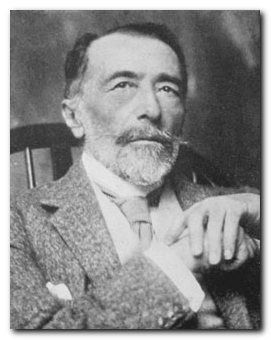
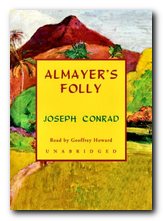 Almayer’s Folly
Almayer’s Folly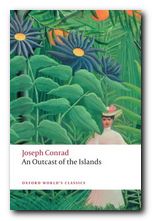 An Outcast of the Islands
An Outcast of the Islands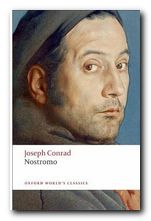 Nostromo
Nostromo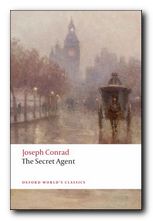 The Secret Agent
The Secret Agent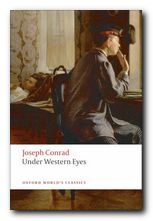 Under Western Eyes
Under Western Eyes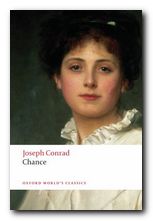 Chance
Chance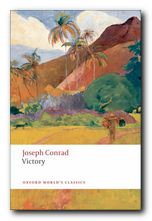 Victory
Victory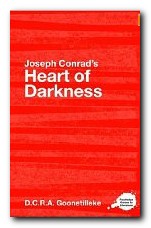
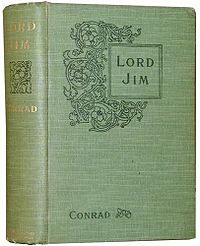 Jim is a young English sailor fired with romantic dreams of heroism in the face of danger. On a sea voyage transporting pilgrims from Singapore to Jeddah in the Red Sea, his ship the Patna is involved in a collision. Thinking that the vessel is sinking, the crew (including Jim) abandon ship. However, the ship does not sink, but is rescued by a French boat and towed to safety. There is an official inquest into the incident in Bombay, before which the German captain absconds and at which Jim is stripped of his seaman’s certificate in dishonour.
Jim is a young English sailor fired with romantic dreams of heroism in the face of danger. On a sea voyage transporting pilgrims from Singapore to Jeddah in the Red Sea, his ship the Patna is involved in a collision. Thinking that the vessel is sinking, the crew (including Jim) abandon ship. However, the ship does not sink, but is rescued by a French boat and towed to safety. There is an official inquest into the incident in Bombay, before which the German captain absconds and at which Jim is stripped of his seaman’s certificate in dishonour. The Cambridge Companion to Joseph Conrad offers a series of essays by leading Conrad scholars aimed at both students and the general reader. There’s a chronology and overview of Conrad’s life, then chapters that explore significant issues in his major writings, and deal in depth with individual works. These are followed by discussions of the special nature of Conrad’s narrative techniques, his complex relationships with late-Victorian imperialism and with literary Modernism, and his influence on other writers and artists. Each essay provides guidance to further reading, and a concluding chapter surveys the body of Conrad criticism.
The Cambridge Companion to Joseph Conrad offers a series of essays by leading Conrad scholars aimed at both students and the general reader. There’s a chronology and overview of Conrad’s life, then chapters that explore significant issues in his major writings, and deal in depth with individual works. These are followed by discussions of the special nature of Conrad’s narrative techniques, his complex relationships with late-Victorian imperialism and with literary Modernism, and his influence on other writers and artists. Each essay provides guidance to further reading, and a concluding chapter surveys the body of Conrad criticism.
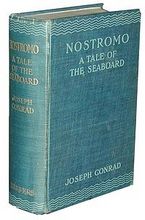 The location of the novel is Costaguana, a fictional country on the western seaboard of South America, and the focus of events is in its capital Sulaco, where a silver mine has been inherited by English-born Charles Gould but is controlled by American capitalists in San Francisco. Competing military factions plunge the country in a state of civil war, and Gould tries desperately to keep the mine working. Amidst political chaos, he dispatches a huge consignment of silver, putting it into the hands of the eponymous hero, the incorruptible Capataz de Cargadores, Nostromo.
The location of the novel is Costaguana, a fictional country on the western seaboard of South America, and the focus of events is in its capital Sulaco, where a silver mine has been inherited by English-born Charles Gould but is controlled by American capitalists in San Francisco. Competing military factions plunge the country in a state of civil war, and Gould tries desperately to keep the mine working. Amidst political chaos, he dispatches a huge consignment of silver, putting it into the hands of the eponymous hero, the incorruptible Capataz de Cargadores, Nostromo.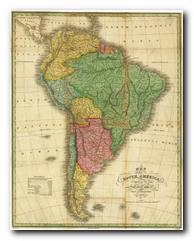 A great deal of the narrative tension in this long novel turns on who knows what about whom, and many of the key scenes are drenched in dramatic irony built on coincidences which have all the improbability of the nineteenth century novel hanging about them. At one point a completely new character suddenly appears as a stowaway on a boat, and then improbably survives a collision with another ship in the dark by hanging onto the other boat’s anchor. And this is merely a plot device allowing him to transmit misleading information to his captors – and incidentally allows Conrad to indulge in a rather unpleasant bout of anti-semitism.
A great deal of the narrative tension in this long novel turns on who knows what about whom, and many of the key scenes are drenched in dramatic irony built on coincidences which have all the improbability of the nineteenth century novel hanging about them. At one point a completely new character suddenly appears as a stowaway on a boat, and then improbably survives a collision with another ship in the dark by hanging onto the other boat’s anchor. And this is merely a plot device allowing him to transmit misleading information to his captors – and incidentally allows Conrad to indulge in a rather unpleasant bout of anti-semitism.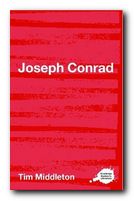 The Complete Critical Guide to Joseph Conrad is a good introduction to Conrad criticism. It includes a potted biography, an outline of the stories and novels, and pointers towards the main critical writings – from the early comments by his contemporaries to critics of the present day. Also includes a thorough bibliography which covers biography, criticism in books and articles, plus pointers towards specialist Conrad journals. These guides are very popular. Recommended.
The Complete Critical Guide to Joseph Conrad is a good introduction to Conrad criticism. It includes a potted biography, an outline of the stories and novels, and pointers towards the main critical writings – from the early comments by his contemporaries to critics of the present day. Also includes a thorough bibliography which covers biography, criticism in books and articles, plus pointers towards specialist Conrad journals. These guides are very popular. Recommended.